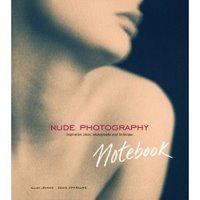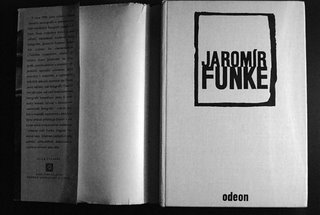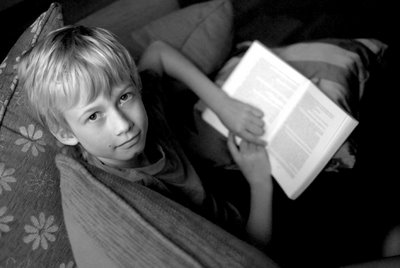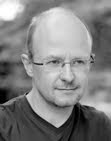
End of August, early September I trekked a few days through the Brenta Dolomites, a wild calcareous mountain range in the north of Italy, just west of Trento. I had been in the Brenta a long time ago and came away very impressed with the stunning, even savage character of the landscape. This time I was accompanied by my friend Werner Everaerts, my friend and colleague Jos Mertens and our mountain guide Martin Kopfsgüter (from Globo Alpin in Toblach). Our plan was to do a north-south traverse of the Brenta range following a circuit of vertiginous "via ferrata". These are mountain trails equipped with cables and ladders, leading the trekker over a series of exposed ledges and walls. This is not really climbing but requires stamina and the ability to keep the head cool in very "airy" conditions.
When I was in the Brenta ten years ago, I wasn't really into photography. But I do remember having my trusted Olympus OM-10 with a fixed 35mm lens in my backpack. Remarkably it was loaded with black & white film - a very rare occasion. I also remember being very disappointed with the pictures, particularly with respect to the strange, cardboard-like texture of the mountains. The Dolomites are unique sofar as they combine pure minerality with a very outspoken vertical dimension. It is very hard to give a faithful rendering of the chaotic, unstable, epic dimensions of this landscape.
That is why this time I decided to take my large format gear with me. Of course, taking a 4x5" camera on a strenuous mountain hike brings its own logistic problems. You have to take everything, including daily stuff, storm gear, water, food, climbing apparel and camera on your shoulders. First i took my Lowe Orion 3 photo bag and put the Canham, a Quickload cassette, the black cloth (an old t-shirt) and the 150mm lens in it. Then I took an old 70 liter 2-compartment backpack and put the Orion in the bottom compartment. It fitted nicely. On top went all the other stuff, including 40 sheets of Quickload Acros and the 300 mm lens. Initially I thought off taking also the 450mm and the 90mm with me, but I decided against because of weight and volume reasons. This proved to be a good decision as I exposed 75% of 35 sheets with the normal lens and the rest with the 300mm. I certainly felt no need for the wide angle and also the 450mm is a nice to have rather than a must.
I didn't weigh my backpack, but it was very heavy. Remember the Gitzo G1325 carbon tripod with a Manfrotto geared head was fixed on the outside of the pack. And, oh yes, I also took the Voigtländer Bessa-L with the 15mm Heliar for some action snaps. I estimate the pack's total weight between 23 and 25 kilograms.
The first day we went from the Rifugio Graffer at the Passo del Groste to the Alimonta hut. That proved to be a very tough circuit over the Sentiero Benini and the Sentiero delle Bocchette Alte. The latter is constantly hovering around 3000m leading you over what seems an endless succession of terraces, ledges, towers and passes. It took us 11 hours to get to our destination and I must admit of being completely knocked off my socks by the end of the day (I took about 8 pictures on that day). We had some snow on the way down to the hut and the next morning we woke up to a beautiful, raw landscape covered with a thin layer of powder.
The approach to the next leg, the Sentiero delle Bocchette Centrale, was very atmospheric with strong gusts of wind sending clouds of powder snow in the air. The part of the sentiero that was exposed to these cold northern winds was covered with a thin layer of ice and this required our utmost attention. Luckily, our guide Martin had volunteered to carry the tripod and that made a difference. It was a fairly short but very impressive trek to the Pedrotti hut that day. I had plenty of time after our arrival to expose some more snaps in the area around the hut. In the evening we enjoyed the excellent hospitality of these Italian huts and I was quickly recuperating after the marathon the day before.
Day 3 brought us from the Pedrotti hut to the base of the Cima Tosa, the highest mountain of the Brenta range (at 3173m). We left the packs at the base of the "black chimney" and Martin guided a few pitches up the southeast face of the mountain. Our summit pause was very brief because of the fierce and very cold winds. By now the weather had evolved into to a glorious late summer high, with warm colours and superbly clear skies, allowing for richly detailed and wide vistas. After our descent, we followed the Sentiero Brentari to the Agostini hut. The final part was fantastic. I will never forget coming around the corner of a ledge and standing eye to eye with the magnificent south wall of the Cima d'Ambiez. Sadly the location didn't offer itself for setting up a 4x5" outfit.
We spent the night in the Agostini hut and prepared for a long trek on the fourth and last day. We started early out on the Via Castiglioni, a ferrata that leads to a small col via a series of long and exposed ladders. Then we descended tot the XII Apostoli hut where we had an excellent minestrone. Then up to the Bocca dei Camosci and then into the wild valley skirting the west face of the Crozzon di Brenta. Descent (and ascent) to the Brentei hut, from which the long descent into Madonna di Campiglio starts.
It took quite some effort to do this whole circuit with large format gear. It's heavy (I still have "stigmata" on both my shoulders of the backpack straps that were rubbing in my flesh). And it takes a different kind of effort to set up your 4x5" to take a picture. Whilst you setting up, composing, exposing and loading everything back in your pack, your team mates may have a rest, but you aren't. You remain physically and mentally very involved. Rushing to take the pictures as quickly as you can, you don't often take the time to eat or drink. This will cause problems later on. So it takes commitment and stamina, no doubt. On the other hand, I have now proof that it is eminently doable to take a 4x5" camera and 40-50 sheets of film on a week-long trek even on extreme terrain (for photographers) such as these via ferrata. That opens a lot of future opportunities.
Best of all: I have the results now back from the lab and I am satisfied with them. More on what I really would like to do with this project later on ...
The picture above was taken by Jos Mertens shortly after our ascent of Cima Tosa, with the Voigtländer Bessa L and the Heliar 15mm on Fuji Neopan 400.
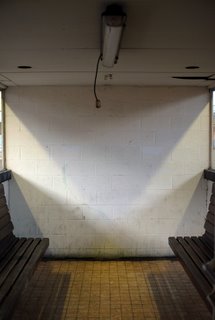 I have been further experimenting with the D80. Now that I have the Sigma 30/1.4 lens at my disposal, I am quickly warming to digital technology. ;-) It has been a delight to swap the Nikkor 18-135 kit lens for this fixed focal length. The zoom feels plasticky and simply doesn’t inspire confidence. And I generally don’t like zoom lenses. They are making me nervous. With a fixed lens, you know what mental frame to carry around. With a zoom the visual imagination loses focus and ends up nowhere.
I have been further experimenting with the D80. Now that I have the Sigma 30/1.4 lens at my disposal, I am quickly warming to digital technology. ;-) It has been a delight to swap the Nikkor 18-135 kit lens for this fixed focal length. The zoom feels plasticky and simply doesn’t inspire confidence. And I generally don’t like zoom lenses. They are making me nervous. With a fixed lens, you know what mental frame to carry around. With a zoom the visual imagination loses focus and ends up nowhere. 